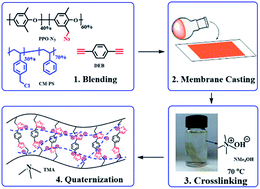Semi-interpenetrating polymer networks by azide–alkyne cycloaddition as novel anion exchange membranes†
Abstract
A series of semi-interpenetrating polymer network anion exchange membranes (semi-IPN AEMs), composed of a quaternized poly(styrene) (PS) copolymer and crosslinked poly(2,6-dimethyl-1,4-phenylene oxide) (PPO) networks, have been designed and fabricated. In this system, quaternized PS served as an anion transport moiety, while crosslinked PPO networks formed by azide–alkyne cycloaddition under an organic base were expected to maintain the mechanical properties and dimensional stability of the resulting semi-IPN AEMs. The semi-IPN AEMs showed improved mechanical properties compared to the control sample prepared by physical blending without crosslinking. It was found that the sIPN-62/30 AEM with an IEC of 1.44 meq. g−1 showed the highest hydroxide conductivity of 37.2 mS cm−1 at 20 °C and a relatively low swelling ratio of 12% at 20 °C in water. Further increasing the fraction of the linear conductive component (sIPN-75/20) led to a dramatic increase of water uptake, which diluted the ion concentration in the AEMs, consequently decreasing the hydroxide conductivity of the membrane (28 mS cm−1 at 20 °C). However, a high mechanical strength and low swelling ratio were observed for sIPN-75/20 samples due to the presence of hydrophobic crosslinked PPO networks. The alkaline stability of the semi-IPN AEMs was evaluated in 1 M NaOH at 80 °C. 59.1%, 86.7% and 74.8% retention in hydroxide conductivity, weight and IEC values were recorded for the sIPN-62/30 AEM respectively after 700 h testing. This result indicated that the crosslinked networks in semi-IPN AEMs can effectively protect the cations from being attacked by hydroxide ions. A single H2/O2 alkaline fuel cell of the sIPN-62/30 membrane demonstrated that a maximum power density of 110.6 mW cm−2 was achieved at a current density of 280 mA cm−2 at 60 °C. Although a loss of 78.3% of its initial performance was observed for the sIPN-62/30 membrane after 30 h alkaline fuel cell durability testing at 100 mA cm−2, high retention in IEC values and hydroxide conductivity for the aged sIPN-62/30 membrane shows that the semi-IPN AEMs based on BTMA cations are chemically stable under fuel cell operation conditions.



 Please wait while we load your content...
Please wait while we load your content...